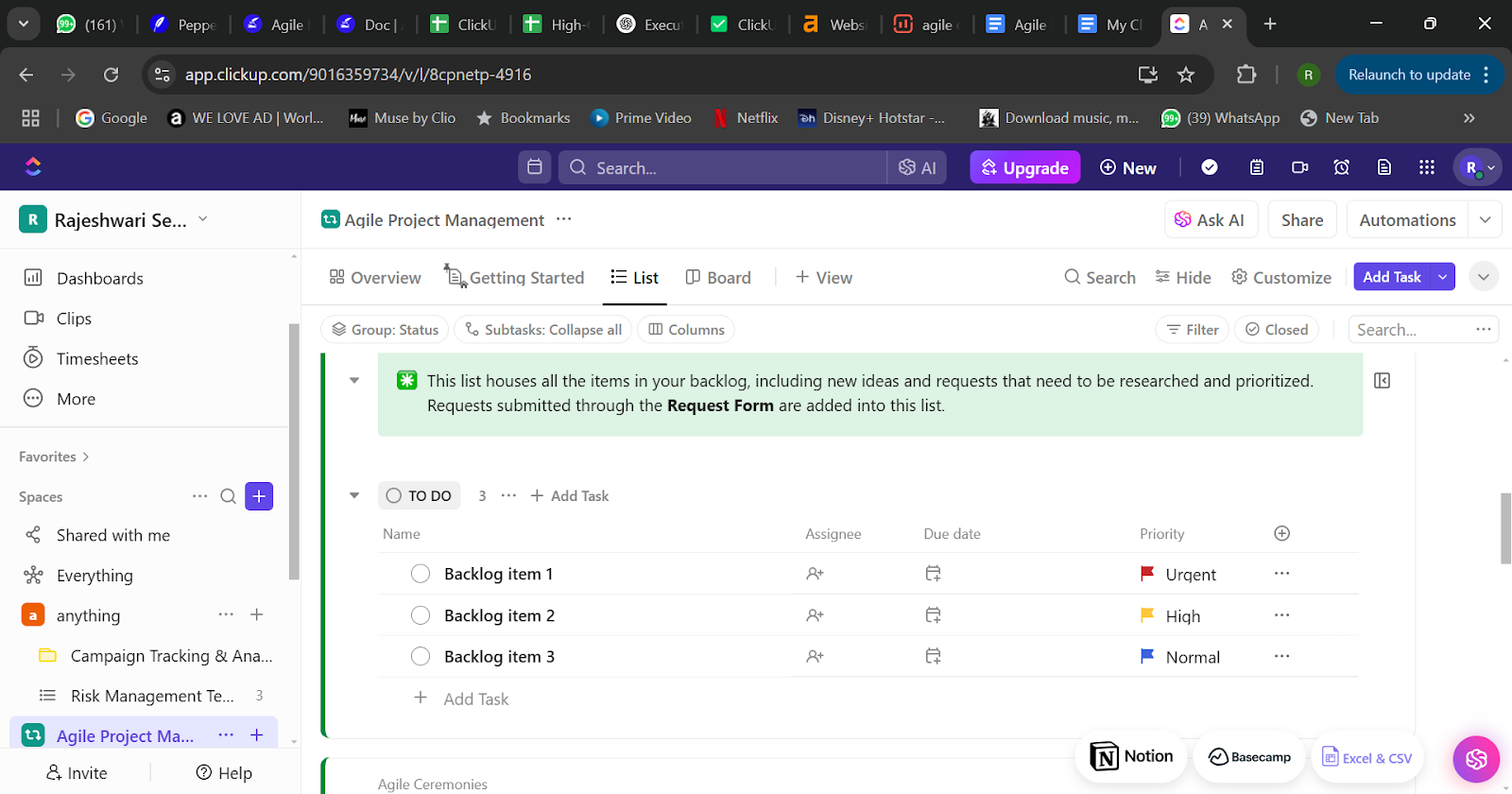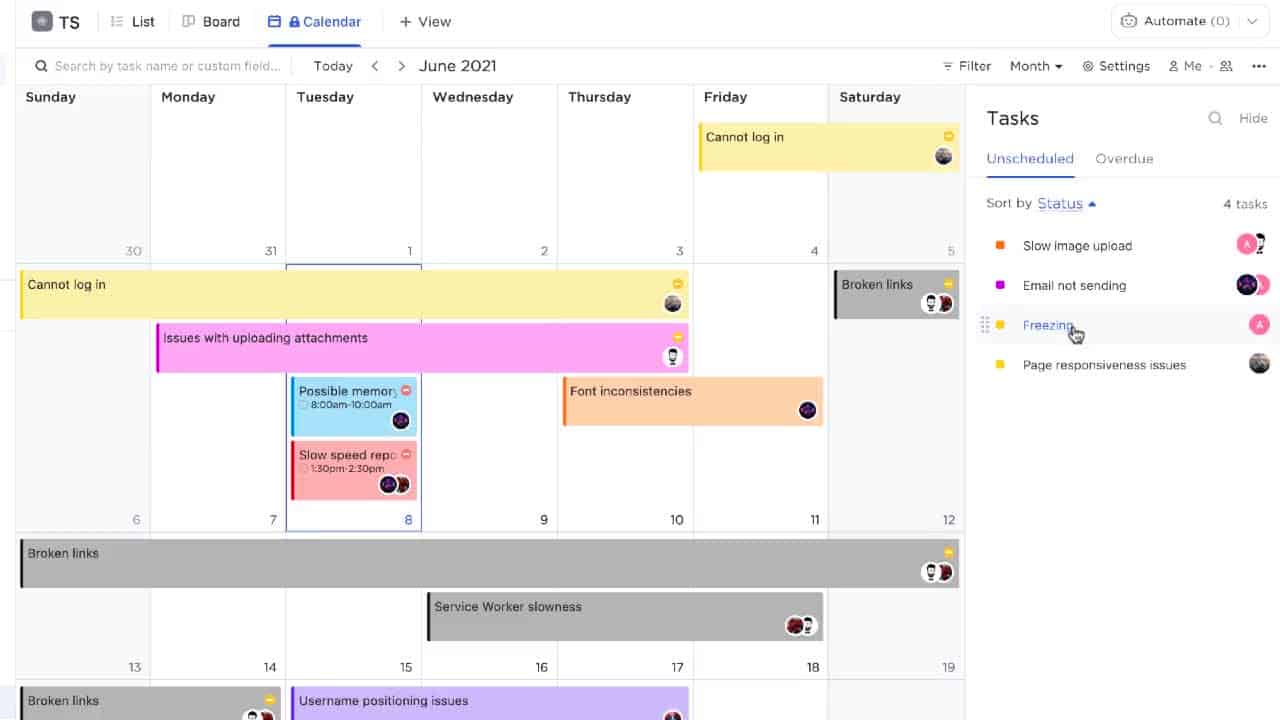How to Conduct Agile Meetings for Project Managers

Sorry, there were no results found for “”
Sorry, there were no results found for “”
Sorry, there were no results found for “”

If we’re so busy with meetings, why isn’t anything getting done? 🤔
Project managers often have this question while they struggle to conduct productive team meetings.
A recent McKinsey study revealed that over 80% of executives want to change meeting structures for better effectiveness.
Yet, for many of them, achieving this level of agility in meetings remains a challenging goal. Let’s simplify this difficult task and make it more achievable.
In this article, we’ll walk you through the art of conducting Agile Meetings.
Read more to explore what Agile meetings mean, their components, and their types. We’ll also deep dive into how to conduct Agile meetings, the do’s and don’ts, and the best practices for driving tangible business outcomes from them.
Agile meetings function on Agile methodologies to make meetings more collaborative, productive, and purpose-driven. The main idea behind Agile meetings is for the team to complete projects by breaking them into parts and working on them in shorter bursts, reflecting, adjusting, and improving over time.
Make Agile meetings smoother and more effective! Try ClickUp’s free Agile Project Management Template to stay organized and keep your team aligned. 🚀
The term ‘Agile’ was initially coined in software development. However, over the years, it gained popularity as an effective technique to improve results among other teams and industries.
Agile meetings happen at specific points during a sprint cycle or development process. The team shares progress updates in each meeting, plans the next steps, discusses client feedback, and exchanges critical project info.
Knowing who participates in scrum meetings and becoming familiar with scrum terms is essential. In Agile Scrum meetings, you’ll typically find the following attendees:
There are different types of Agile meetings since Agile is not a rigid framework but a governing set of ideals and principles.
In project management, there are four types of Agile meetings: Sprint planning, Daily scrum or standup, Sprint review, and Sprint retrospective. Let’s deep dive into the goals of each meeting and how to conduct them efficiently.
In the sprint planning meeting, you and your team gather to map out your game plan for the next project development timeline, the sprint.
During this meeting, the team brainstorms the sprint goals they want to achieve and plans strategies, considering what the organization wants, how long the tasks might take, and who’s responsible for each task.
Simply put, the main goals of the sprint planning meeting are:
This meeting ensures everyone’s on the same page and sets you up for success in the upcoming sprint.
Now, to run a successful sprint planning meeting, here’s what you need to do:
Result: By the end of the meeting, you’ll have a clear action plan for the sprint ahead.
The daily scrum or standup meeting is a brief check-in conducted regularly during the sprint timeline. This scrum process is usually the shortest and the most frequent Agile meeting out of all four types of meetings.
Its purpose is for the scrum team to discuss the progress of tasks, identify any roadblocks, and ensure everyone is on track. During standups, each team member is asked to answer three questions:
The scrum master facilitates the daily standup meeting, notes any issues raised, and provides solutions afterward. Overall, the daily standup ensures transparency, collaboration, and alignment within the team.
Let’s look into some tips to run daily scrum meetings smoothly, ensuring your team stays organized and motivated:
Result: Consistently running daily scrum meetings and monitoring the team’s accomplishments will help identify and resolve potential roadblocks.
A sprint review meeting is a scrum meeting where the development team demonstrates the work completed during the sprint to stakeholders, such as product owners, project managers, or investors.
The sprint review typically occurs at the end of each sprint. Ideally, the product presentation and review should last between one and two hours, allowing sufficient time for presentations and feedback sessions.
To make a sprint review meeting more effective, consider the following:
Result: The sprint review meeting is an opportunity to oversee the team’s capabilities, gather feedback, discuss any changes needed, and plan the next steps.
The sprint retrospective meeting is held after the sprint review to reflect on the team’s performance during the sprint.
Led by the Scrum master, this meeting involves discussions on what went well, problem areas, and tasks that could have been improved. The session aims to evaluate the previous sprint and establish action items to improve collaboration and effectiveness in future sprints.
Attendees include the development team and the Scrum master, and the duration typically ranges from 45 minutes to three hours, depending on the sprint length.
Here are some practical ways to enhance the productivity of sprint retrospective meetings:
Consider these do’s and don’ts to conduct an effective Agile meeting:
| Do’s | Don’ts |
| Timebox your meetings for efficient time management, decision-making, and equal attention to all topics. Set specific time limits for each agenda item. | Don’t allow meetings to go off track or overrun unnecessarily, as it leads to loss of productivity and engagement. |
| Stick to the meeting agenda to maintain efficiency and ensure all topics are addressed within the allocated time. | Don’t hold meetings without a clear purpose or agenda, which can result in confusion and wasted time. |
| Resolve impediments to ensure your scrum team has a smoother workflow by collaboratively identifying and addressing any obstacles or blockers that hinder progress. | Avoid micromanaging your Agile meetings by excessively controlling and scrutinizing every detail of your teamwork. It hinders creativity and results in trust issues. |
| Encourage transparency and active participation from all team members to promote collaboration and multiple perspectives. | Don’t interrupt or dominate the conversation; it affects collaboration and creativity. Everyone should have the opportunity to contribute and express their thoughts. |
| Note down key points, decisions, and action items discussed during the meeting so it’s easier to remember and follow up after the meeting. | Don’t multitask during the meetings, as it can signal disinterest and disrupt the flow of communication. Refrain from checking emails, texting, or working on unrelated tasks. |
| Follow up on action items and decisions made during the meeting to ensure accountability and progress. | Avoid early mornings or late afternoons when people might be less alert. Instead, choose a time when everyone is most ready to focus. |
Let’s dive into some tips and best practices to conduct Agile meetings:
Transform your Agile meetings with ClickUp—a dynamic tool to boost collaboration and efficiency.
Use ClickUp’s Agile Project Management to manage your team, plan, organize, and execute Agile meetings—sprint planning, daily stand-ups, or retrospective sessions.

ClickUp has intuitive features and Agile templates tailored for Agile methodologies like Scrum or Kanban. They help you organize your work, track progress, and collaborate effectively with your team.
ClickUp ensures that your Agile meetings are productive, focused, and actionable, empowering teams to achieve their goals easily.
Let’s deep dive into critical features of ClickUp that help conduct Agile meetings hassle-free.
Leverage ClickUp Meetings to do everything you need for your Agile meetings in one place.

Here’s how it works:
Don’t spend hours planning meeting agendas, capturing notes, and assigning tasks.
With ClickUp Brain, effortlessly streamline the meeting process, from agenda creation to note summarization. It’s your ultimate AI assistant for enhancing your Agile meetings.

Keep your projects on track and your team aligned with ClickUp’s Calendar View.

Here’s how it works:
ClickUp Reminders are like your personal assistant for Agile meetings, keeping you and your team on top of things.

Here’s how they make your life easier:
Staying focused during project meetings is vital to ensure efficient use of time, productive discussions, and alignment toward project goals. Here are some tips that will help you:
Bonus: How To Focus and 7 Ways To Improve Concentration
Maintaining a disciplined flow during Agile meetings is like sticking to a roadmap—it keeps everyone on the same path. By staying organized and focused, Agile teams make the most of their time together, fostering better teamwork and achieving their goals more effectively.
Here are a few things you must do to maintain an efficient flow during Agile meetings:
Preparation for Agile meetings sets the stage for productive discussions and informed decision-making. Follow these steps to prepare your team for Agile meetings:
In Agile meetings, the importance of avoiding the loss of productive hours cannot be overstated. Every minute wasted equals a missed opportunity to advance toward project goals and deliverables.
Use these strategies to keep you and your team on track during project meetings:
Mastering Agile meetings is pivotal for project managers seeking to enhance team collaboration and productivity.
By implementing the tips and strategies discussed in this article, teams can streamline communication and drive successful scrum project management.
Additionally, ClickUp streamlines project management by offering customizable workflows, real-time collaboration tools, and comprehensive reporting features in one intuitive platform.
Sign Up for FREE and upscale your Agile meetings!
In Agile development methodologies, there are four key meetings, often referred to as the ‘Scrum events’ within the Scrum framework. These meetings are crucial for keeping everyone on the same page, working together smoothly, and making steady progress.
They are:
Scrum has four crucial meetings that help teams communicate and collaborate better.
The Agile framework features four ceremonies—Sprint Planning, Daily Standup, Sprint Review, and Sprint Retrospective—that enhance development teams’ communication, collaboration, and iteration.
© 2025 ClickUp